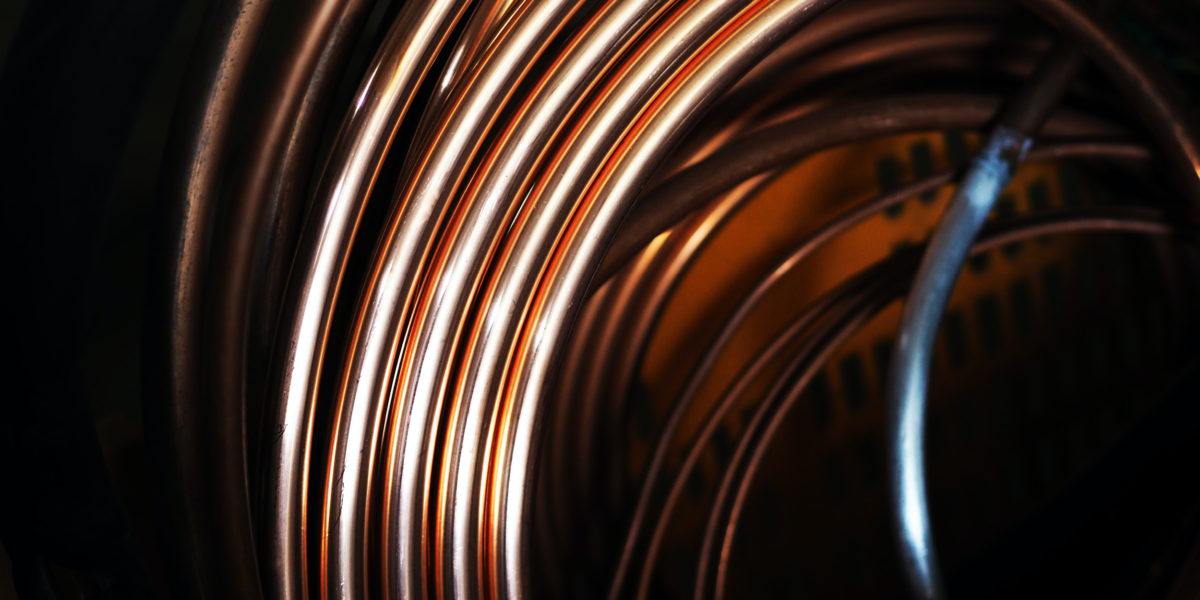Dr copper getting bullish, as red metal rebounds
That famous economist, Dr Copper, has rebounded from his pessimism in March, and is feeling positive.
Copper has long been considered an accurate proxy for global economic health and activity, because of the extent of its use. The red metal is the third-most-used metal in the world behind iron ore and aluminium, and is used in electrical wiring, plumbing, construction, producing industrial machinery, vehicles and cooking equipment. This ubiquity is why copper earned its “doctorate” – because the copper price can diagnose the health of the global economy.
This prescience on the part of copper should only strengthen. Copper’s use in electric vehicle batteries is on the rise, and its anti-microbial properties – first noted, if not understood, by the Ancient Egyptians – have won it many a headline during the COVID-19 pandemic, to the extent that copper’s applications in hospital, healthcare and public spaces, on surfaces that are constantly touched, should also skyrocket in future.
Even before the renaissance of copper as a hospital-fittings and public-space building component was sparked by the pandemic, the McKinsey Global Institute was projecting that copper consumption would surge by 43%, by 2035, on the back of electric vehicles (EVs).
Morgan Stanley expects electric cars – and the charging infrastructure to support them – to need 1.1 million tonnes of copper by 2025, a six-fold surge in demand from 2017.
That’s expected to grow to 1.7 million tonnes by 2027 according to the International Copper Association (ICA).
Renewable energy is also a major driver of copper demand: the metal dominates the composition of both wind turbines, and photovoltaic (PV) systems used in solar power.
It’s all looking good for copper in the future – and in the present.
After having lost 21% in price in the February/March COVID-19 crash, copper has rebounded by 27%, to be down less than 1% in 2020.
A combination of factors including solid demand in China (the biggest user of copper), massive global economic stimulus, supply disruption in South America, and low stockpiles have helped to push copper prices to a five-month high. Reports of tension between mining companies and labour unions in Chile, the largest producer, have the copper market wary of supply risk.
Here’s a look at three major copper stocks, apart from diversified miners BHP and Rio Tinto:
Sandfire Resources Limited (SFR, $4.97)
FY21 estimated yield: 2.9%, fully franked (grossed-up, 4.2%)
Analysts’ consensus target price: $5.48 (Thomson Reuters), $5.639 (FN Arena)
Prior to COVID-19, Sandfire was expecting to produce 70,000-72,000 tonnes of copper and 38,000-40,000 ounces of gold from its De Grussa mine in Western Australia, but withdrew that guidance in April; however, it is still running the mine and plant at full operational capacity, and produced 17,936 tonnes of copper and 9,352 ounces of gold during the March quarter, down from 18,258 tonnes of copper and 10,723 ounces of gold in the December 2019 quarter. In May, Sandfire reinstated its guidance.
In Botswana, Sandfire is working on the Feasibility Study for the T3 Copper-Silver Project in Botswana, and is also at Feasibility Study stage on the Black Butte Project in Montana.
De Grussa is a high-grade copper mine, with a grade of 5% – and at current gold prices, its by-product gold production (at a grade of 2 grams a tonne) is a very handy revenue bonus, at a time when the A$ gold price in Australian dollars at near-record levels.
Brokers are reasonably bullish on Sandfire: the consensus of the three upgrades to consensus target price made in June is $5.76.
IGO Limited (IGO, $4.93)
FY21 estimated yield: 2.7%, 55% franked (grossed-up, 3.3%)
Analysts’ consensus target price: $5.50 (Thomson Reuters), $5.09 (FN Arena)
IGO mines nickel, copper and cobalt – with nickel the major focus – at Nova in Western Australia, and also has a 30% stake in the Tropicana Gold Mine in WA. In the March 2020 quarter, production for all metals at Nova exceeded IGO’s pro rata FY2020 guidance, with 8,019 tonnes of nickel, 3,748 tonnes of copper and 303 tonnes of cobalt for the March quarter.
This was the highest quarterly production on record for copper and the second highest quarterly production for nickel, positioning Nova to deliver at (or above) the top end of its production guidance, for 27,000 tonnes-30,000 tonnes of nickel; 11,000 tonnes-12,500 tonnes of copper; and 850 tonnes-950 tonnes of cobalt.
However, Tropicana struggled in the March quarter, with production lower at 103,858 ounces, in line with the company’s expectations of lower grades and higher costs. IGO expects Tropicana to still make the lower end of its guidance range of 337,500 ounces-375,000 ounces. Still, like Sandfire, the gold is a very nice attribute to have at present
These guidance numbers should be enough to push earnings per share (EPS) to 28 cents for FY20, up from 12.4 cents in FY19, with a one-cent increase in dividend expected, to 11 cents.
The Thomson Reuters analysts’ consensus target price – drawn from 14 analysts – is significantly more optimistic than FN Arena’s, which is drawn from a sample of six.
OZ Minerals (OZL, $11.30)
FY20 (December) estimated yield: 1.2%, fully franked (grossed-up, 1.7%)
Analysts’ consensus target price: $11.40 (Thomson Reuters), $11.16 (FN Arena)
Copper-gold-silver miner OZ Minerals operates the Prominent Hill copper-gold-silver mine and the Carrapateena iron oxide-copper-gold mine, both in South Australia. OZ produced its first saleable copper-gold concentrate from Carrapateena mine in December last year.
Production at Carrapateena is expected to continue to ramp up during 2020 in the range of 20,000 tonnes-25,000 tonnes of copper and 35,000 ounces-40,000 ounces of gold. But the company has kickstarted plans to transform the Carrapateena mine into a block cave operation, to significantly increase both its production and its mine life.
The block cave conversion would see Carrapateena’s expected throughput rate of 4.7-5 million tonnes a year from 2023 increased to 12 million tonnes a year – and it also has the potential to nearly double Carrapateena’s average annual production, to 110,000-120,000 tonnes of copper and 110,000-120,000 ounces of gold from 2026.
In the March quarter of 2020 (the first quarter for Oz, which is a calendar-year reporter), Oz Minerals produced 20,231 tonnes of copper and 55,606 ounces of gold. The company has provided full-year production guidance of 83,000-100,000 tonnes of copper and 207,000-234,000 ounces of gold. The company is expected to have moved to a net cash-positive position in the June quarter, and remain there for the rest of the year.
The company is also moving to full ownership of the West Musgrave Project, in Western Australia, which is Australia’s largest undeveloped copper-nickel deposit.
Oz Minerals’ ambitious expansion plan at Carrapateena should be seen as locking-in growth for the company, but the problem for investors is that OZL is seen as fully valued at present – although that is significantly skewed by an underwhelming price target of $8.60 at Credit Suisse.









